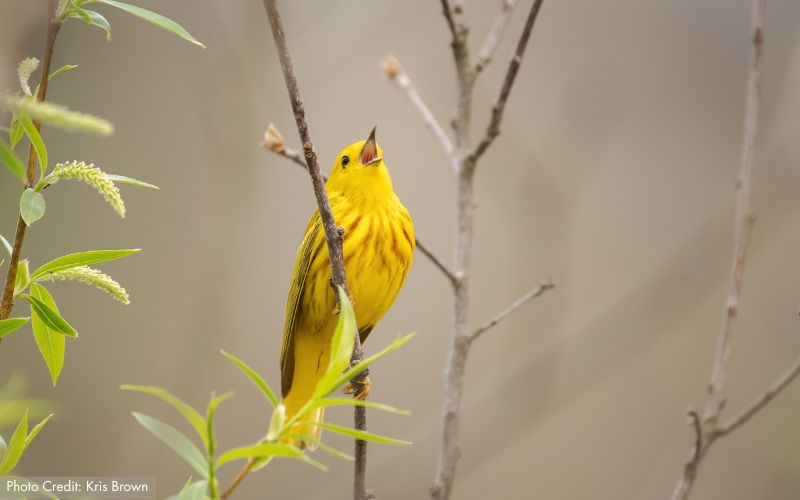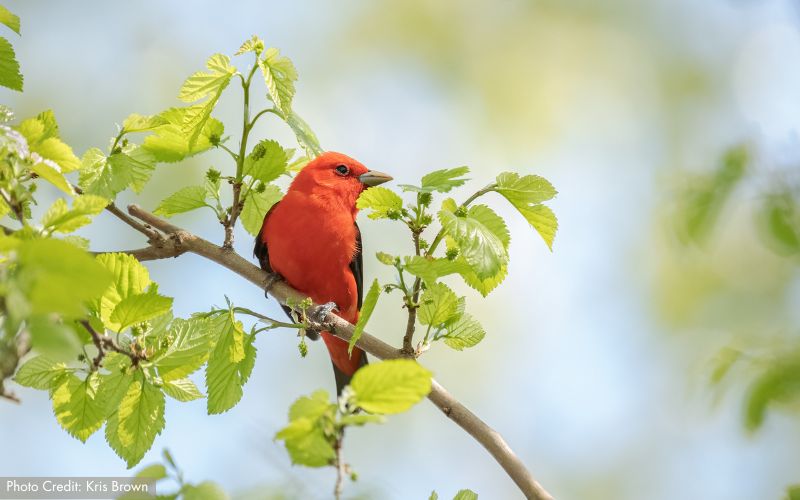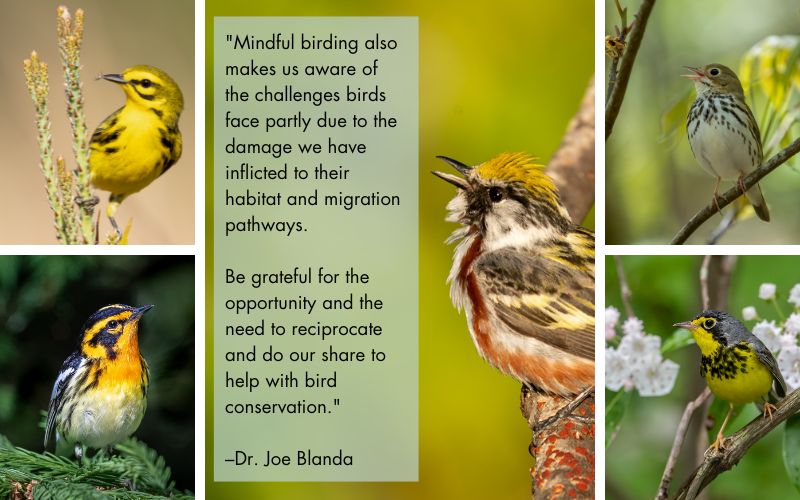by Brandon Henneman
Each year, on the second Saturday in May, World Migratory Bird Day is celebrated in North America! One of the primary goals of this day is to promote the urgent need for migratory bird conservation. Bird populations are in decline, and research indicates that we have lost as much as 25% of the overall bird population since 1970. The decrease is a result of several factors, including habitat loss. Research shows a decline in the availability of quality habitat for both migration corridors and suitable nesting sites over the past 50 years. Cuyahoga Valley National Park (CVNP) encompasses over 33,000 acres of parkland, and this large, protected habitat is an essential migratory pathway and breeding site for numerous birds.

CVNP is home to approximately 250 different bird species throughout each year and is located within an important flyway that connects the Great Lakes to the Gulf of Mexico by way of the Mississippi, Ohio, and Cuyahoga River corridors. Birds migrate in search of available food sources and suitable nesting habitats. Each spring, long distance migrants can travel up to 4,000 miles (or more) to reach their breeding grounds. This may entail long, non-stop flights over open water, like the Gulf of Mexico, and include up to 24 hours (or more) of continuous flight without food, water, or rest! Some birds have been documented traveling these long distances to visit the same stopover sites or nest in the exact same location as in previous years.
It is not fully known how birds navigate so well over such extreme distances. Controlled studies indicate that birds use a combination of celestial bodies (sun, moon, and stars) to navigate and utilize landmarks to find their way. They also may have the ability to detect magnetic north though the earth’s magnetic field! The majority of migration flights occur at night, beginning shortly after sunset. During peak migration, over 250,000 individual birds will fly over CVNP on a given night. Millions of birds will pass through during the month of May, regularly flying as high as 10,000 feet above ground and utilizing weather patterns to assist their movement.
In celebration of this monumental migratory feat and World Migratory Bird Day, below is information* on several interesting and beautiful bird species found in CVNP. Perhaps if you spend a little time on your next CVNP adventure intently looking and listening for birds, you’ll see or hear something new!
BALTIMORE ORIOLE

Wintering Grounds: Florida, Caribbean, Central America, and Northern South America.
Preferred Habitat: High in leafy deciduous trees but not in deep forests. Prefers open woodland, forest edge, riverbanks, and small groves of trees. Sometimes found in backyards and small urban parks during migration.
Where to Spot in CVNP: Beaver Marsh and along the Towpath Trail.
Tip for Locating: Has a loud, easily recognizable song that it sings from the treetops in spring. If you hear their song, look for a bright orange (sometimes rich yellow) bird perched or flitting though the upper foliage.
Fun Fact: Baltimore Orioles got their name from their bold orange and black plumage, the same colors as the heraldic crest of England’s Baltimore family (who also gave their name to Maryland’s largest city).
INDIGO BUNTING

Wintering Grounds: Southern Florida to northern South America.
Preferred Habitat: Breeds in brushy and weedy areas. Commonly seen along edges of woods and fields, along roads, streams, rivers, and powerline cuts. May visit backyard feeders for thistle or nyjer, or for mealworms.
Where to Spot in CVNP: Station Road Bridge and along the Towpath Trail. Along trails that travel through deeper woods, they can be found singing and nesting along powerline cuts.
Tip for Locating: Sings from tall perches along forest edges and forages for seeds and insects in low brushy vegetation.
Fun Fact: In the late 1960s, Indigo Buntings demonstrated the ability of birds to use the night stars for navigation through a study that observed them in a planetarium as well as under the natural night sky. The study found that birds possess an internal clock that enables them to continually adjust their angle of orientation to a star, even as the star moves throughout the night sky.
YELLOW WARBLER

Wintering Grounds: Central America and Northern South America.
Preferred Habitat: Thickets and disturbed edges, particularly along streams and wetlands.
Where to Spot in CVNP: Beaver Marsh, Indigo Lake, and along the Towpath Trail.
Tip for Locating: Look and listen for a small, bright yellow bird singing and foraging from willows, wet thickets, roadsides, rivers, and streams.
Fun Fact: One of the most numerous warblers in North America, Yellow Warblers typically form monogamous pairs that may last more than one breeding season, reforming as a pair the next season.
SCARLET TANAGER

Wintering Grounds: Northern and Western South America as far south as the Bolivian lowlands, mostly on hills and mountains.
Preferred Habitat: Mature deciduous and mixed deciduous-coniferous forests. Prefer large forest tracts with large trees. May visit native backyard berry plants during migration.
Where to Spot in CVNP: Along the Bike and Hike trail near Sagamore Road. Sometimes found along the Towpath trail during migration but tend to prefer habitat with more dense forest cover and mature trees.
Tip for Locating: Can be hard to see in their preferred habitat, high in the treetops of dense forest canopy. If you see a bright red bird, look for the Scarlet Tanager’s smaller size and dark, jet-black wings and tail to differentiate it from the more well known and more abundant Northern Cardinal.
Fun Fact: Female Scarlet Tanagers sing a shorter, softer, less harsh song than their male counterparts. She sings in answer to the male’s song while she is gathering nesting material.
BLACK-THROATED GREEN WARBLER

Wintering Grounds: Mexico and Central America into central Panama. Bahamas and Central Antilles (especially Cuba and Jamaica).
Preferred Habitat: In CVNP and surrounding areas, often found in and around coniferous trees.
Where to Spot in CVNP: A very small bird that can be difficult to see and much easier to hear. Look and listen near stands of coniferous trees, such as along the Ledges Trail or Hemlock Point along the Plateau Trail.
Tip for Locating: Listen for their “buzzy” song that has an insect quality and is sometimes transcribed as “trees trees I love trees.”
Fun Fact: An untiring songster, one particular male was observed singing its song 466 times in one hour.
If you are new to birdwatching, you don’t need a pair of binoculars to get started. Simply focusing your attention towards looking and listening for birds can help you to spot something new. Of course, many birds are small and high in the treetops, so a good pair of binoculars can help to take your birdwatching to the next level. There are many online and mobile friendly resources to help new birders learn about the birds around them, as well as field guides available for purchase from your local bookseller or online.

Not only is birdwatching a fun pastime, but it can also have positive physical and mental health benefits. Conservancy board member Dr. Joe Blanda is quite experienced in the mental health benefits of nature and birdwatching. For years, he’s been birding in the CVNP area during migration. While he used to race to “hot spots” to see as many warblers as possible, something changed in 2016 when he did a “big year of birding” to raise money for cancer research. Dr. Blanda says, “I developed a deeper appreciation for enjoying mindful birding that year. Being in the presence of such a magnificent phenomenon in such a beautiful surrounding brings me the solace and comfort of a mindful nature immersion.”
Counting and listing birds during migration is a great way to enjoy the outdoors, but mindful birding offers an alternative approach to the experience. Dr. Blanda explains, “Being attentive to the variety of birdsong that migration brings us is as fulfilling to me as making a long list. Noticing the feeding behavior, color patterns, and struggles for survival in their changing habitat brings wonder and awe to me now, where once only having a long list mattered. Birds provide such a wonderful avenue to mindful time in nature.” [To learn more about the health benefits of spending time in nature, visit Dr. Blanda’s website: www.nature-canheal.com.]

If you’re interested in birdwatching, CVNP organizes group bird walks. No experience is necessary to join, and it’s a great way to learn from local experts and explore the fascinating, mysterious world of birds. CVNP also offers mindful hikes, which are also good opportunities to become more aware of birds and other interesting natural features of the park while learning skills to make your time in nature more mindful and beneficial for mental health. To see upcoming events, visit CVNP’s events calendar here.
We hope to see you out on the trails enjoying the many interesting behaviors and beautiful appearances of CVNP’s birds. Happy Birding!
*Some informational notes on individual species taken directly from Cornell Lab of Ornithology website and online bird guide, found at allaboutbirds.org.
Special thanks to the Cuyahoga Valley Photographic Society for generously providing images of migrating birds for this article. If you’re interested in nature photography, join CVPS!





